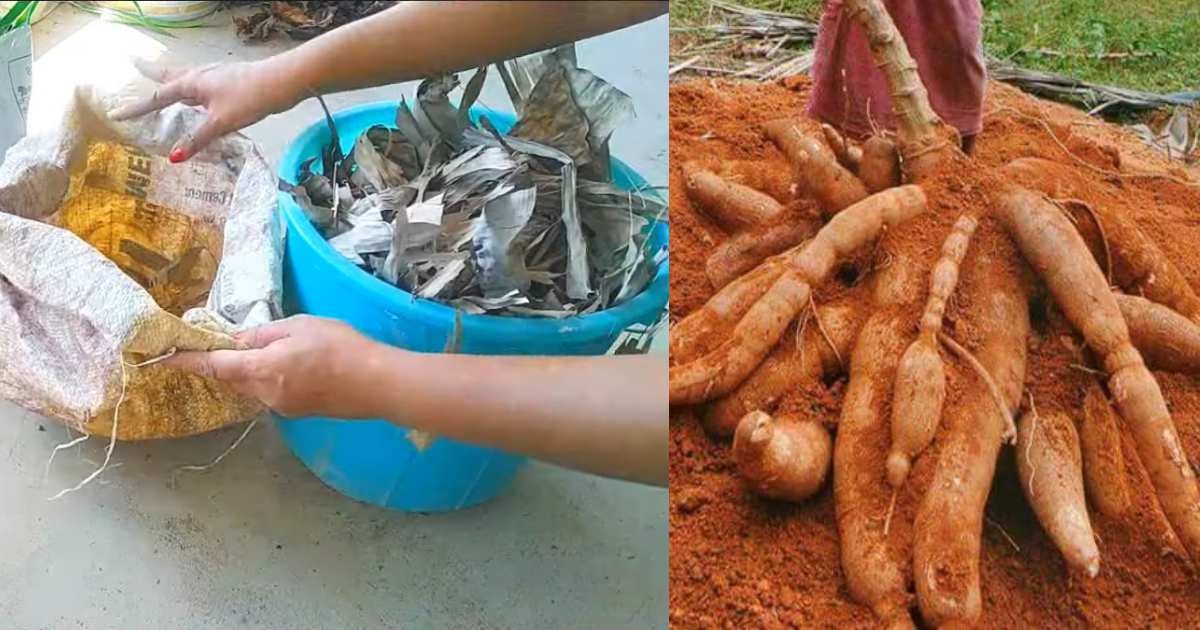
വാഴയില മാത്രം മതി ഇനി 10 കിലോ കപ്പ പറിക്കാം! ഒരു ചെറിയ കപ്പ തണ്ടിൽ നിന്നും കിലോ കണക്കിന് കപ്പ പറിക്കാൻ കിടിലൻ സൂത്രം!! | Kappa Krishi Using Vazhayila
Kappa Krishi Using Vazhayila
Kappa Krishi Using Vazhayila : നമ്മൾ മലയാളികൾക്ക് വളരെയധികം ഇഷ്ടമുള്ള കിഴങ്ങ് വർഗ്ഗങ്ങളിൽ ഒന്നാണല്ലോ കപ്പ. അതുകൊണ്ടു തന്നെ കപ്പയുടെ സീസണായാൽ അത് ഉപയോഗിച്ച് പലതര വിഭവങ്ങളും തയ്യാറാക്കുന്ന പതിവ് നമ്മുടെയെല്ലാം വീടുകളിൽ ഉള്ളതായിരിക്കും. പണ്ടുകാലങ്ങളിൽ വീട്ടാവശ്യങ്ങൾക്കുള്ള കപ്പക്കിഴങ്ങ് തൊടിയിൽ തന്നെ കൃഷി ചെയ്തെടുക്കുന്ന രീതിയാണ് ഉണ്ടായിരുന്നത്. എന്നാൽ ഇന്ന് ഫ്ലാറ്റിലും മറ്റും
ജീവിക്കുന്നവർക്ക് സ്ഥല പരിമിതി ഒരു പ്രശ്നമായി തുടങ്ങിയതോടെ കപ്പ പോലുള്ള കിഴങ്ങ് വർഗ്ഗങ്ങൾ കൃഷി ചെയ്തെടുക്കാൻ സാധിക്കാത്ത അവസ്ഥയായി. എന്നാൽ എത്ര സ്ഥലക്കുറവ് ഉള്ള ഇടങ്ങളിലും ഒരു പ്ലാസ്റ്റിക് ചാക്ക് ഉപയോഗപ്പെടുത്തി എങ്ങനെ വളരെ എളുപ്പത്തിൽ കപ്പ കൃഷി ചെയ്തെടുക്കാൻ സാധിക്കുമെന്ന് വിശദമായി മനസ്സിലാക്കാം. ഈയൊരു രീതിയിൽ കപ്പ കൃഷി ചെയ്യാനായി ആദ്യം തന്നെ അത്യാവിശ്യം
വലിപ്പമുള്ള ഒരു പ്ലാസ്റ്റിക് ചാക്ക് എടുത്ത് അതിന്റെ താഴ്ഭാഗം കട്ട് ചെയ്ത് നടുവിലേക്ക് വലിച്ച് പിടിച്ച് ഒരു കയർ ഉപയോഗിച്ച് കെട്ടിക്കൊടുക്കുക. ശേഷം മുകൾഭാഗം തുറന്നു വെച്ച് അതിലൂടെയാണ് മണ്ണും മറ്റു വളക്കൂട്ടുമെല്ലാം ചേർത്തു കൊടുക്കേണ്ടത്. ചാക്കിന്റെ ഭാരം കുറയ്ക്കാനും ചെടി നല്ല രീതിയിൽ വളരാനുമായി ആദ്യത്തെ ലയർ വാഴയുടെ ഉണങ്ങിയ ഇല ഉപയോഗപ്പെടുത്താവുന്നതാണ്. ഉണങ്ങിയ ഇല ഒന്നിച്ച് മുറിച്ചെടുത്ത് അത് ചാക്കിന്റെ താഴത്തെ ലയറിൽ ഇട്ടുകൊടുക്കുക. ശേഷം മുകളിലായി മണ്ണും ചാണകപ്പൊടിയും മിക്സ് ചെയ്ത് വേണം ഇട്ടുകൊടുക്കാൻ.
അതിന് മുകളിലായി വീണ്ടും മണ്ണ് നിറച്ചു കൊടുക്കുക. വീണ്ടും ഒരു ലയർ കൂടി ചാണകപ്പൊടി വിതറി കൊടുക്കാം. മണ്ണിലേക്ക് അല്പം വെള്ളമൊഴിച്ച് നനഞ്ഞു തുടങ്ങുമ്പോൾ അതിൽ അത്യാവശ്യം നല്ല മൂത്ത ഒരു കപ്പയുടെ തണ്ടു നോക്കി നട്ടു പിടിപ്പിക്കാവുന്നതാണ്. വീണ്ടും മുകളിലായി വാഴയുടെ ഇല ഉപയോഗിച്ച് പൊതയിട്ട് കൊടുക്കാവുന്നതാണ്. ആവശ്യമെങ്കിൽ മാത്രം കൃത്യമായ ഇടവേളകളിൽ തണ്ടിന് ചുറ്റുമായി വെള്ളം നനച്ച് കൊടുക്കാവുന്നതാണ്. കൂടുതൽ വിശദമായി മനസ്സിലാക്കാൻ വീഡിയോ കാണാവുന്നതാണ്. Kappa Krishi Using Vazhayila Video Credit : POPPY HAPPY VLOGS
Tapioca Farming Tips
Tapioca, also known as cassava or kappa, is a widely grown root crop valued for its starchy tubers. It is a staple food in many regions and also used in flour, snacks, and animal feed. Tapioca farming requires less investment, adapts well to different soil types, and provides high yield when managed properly.
Time Required
- Planting to Harvest: 8–10 months
- Early Varieties: Ready in 6–7 months
Tips for Successful Tapioca Farming
- Climate and Temperature
- Grows best in tropical and subtropical regions.
- Ideal temperature: 25–30°C with moderate rainfall.
- Soil Preparation
- Prefers well-drained sandy loam or red soils.
- Avoid waterlogged areas.
- Plough the land well and prepare ridges or mounds for planting.
- Planting Material
- Use healthy stem cuttings (15–20 cm long) from disease-free plants.
- Plant vertically or at a slight angle, 60 cm apart.
- Fertilization
- Apply organic compost before planting.
- Use balanced NPK fertilizer (e.g., 60:60:120 kg/ha) during growth.
- A top dressing of nitrogen 45–60 days after planting increases yield.
- Irrigation
- Requires minimal irrigation but water during long dry spells.
- Avoid excess water to prevent root rot.
- Weed Control
- Keep the field weed-free during the first 2–3 months.
- Mulching with dry leaves helps conserve soil moisture.
- Pest and Disease Management
- Common pests: mealy bugs and mites.
- Use neem oil or bio-pesticides for control.
- Crop rotation reduces disease risks.
- Harvesting
- Harvest when leaves turn yellow and tubers are mature (8–10 months).
- Carefully dig to avoid damage to roots.
Kappa Krishi Using Vazhayila
- Tapioca farming tips
- Cassava cultivation methods
- How to grow tapioca
- Organic tapioca farming
- High yield cassava farming
